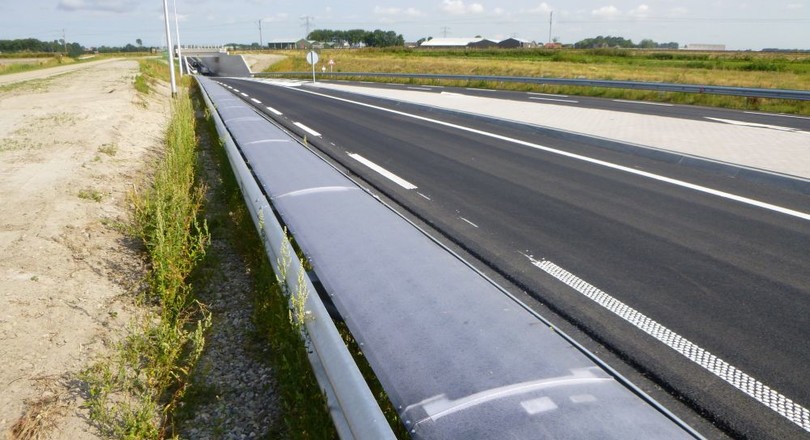
Trials with solar foil on the crash barrier alongside the provincial road near Heerhugowaard have started. Over the coming year, researchers will collect data on how much energy the foil generates, and how it behaves in changing weather conditions.
'We’ve got more than enough miles of crash barriers in the Netherlands,' explains Robert Bezemer of the Netherlands Organisation for Applied Scientific Research TNO about the idea behind the trial. In fact, there are about 7,000 km of barriers spread over the country, so in theory there’s quite a lot of solar energy up for grabs. The supporting structure already exists, in the form of the crash barrier, and these are often free of shade from trees.
To see how this works in practice, a trial has now been started on a 72-metre section of crash barrier alongside the provincial N194 road near Heerhugowaard. 'This section has a double crash barrier, so all we had to do was place solar panels between them.'
Foil keeps crash barriers flexible
Well, that was the initial idea, but then all the practical ifs and buts raised their heads. 'Crash barriers exist for a good reason – they are there for safety and must absorb the energy of a vehicle that goes off the road. They therefore have to be strong and sufficiently deformable at the same time, which meant that using fixed solar panels between the barriers was unworkable. They would make the crash barrier far too stiff.'
That was why the idea arose of using foil, including a structure to attach it to. 'We opted for plastic channels that are flexible enough not to interfere with the function of a crash barrier, but at the same time provide sufficient support for the foil.'

The channels were developed by TNO and construction company Heijmans, which has lots of experience with installing crash barriers. The channels are easy to assemble, and the top part has a slightly convex design. 'The design is good for the sun, it stops rainwater collecting, and allows dirt to be washed off easily.'
The foil is secured to the channels in the factory, after which the channels are mounted in the crash barrier. 'We are using two types of foil in this trial for comparison purposes.'
What is the effect of dirt and the weather?
The foils, with a width of 37 to 50 cm, are installed as modules each a few metres long with their own electrical circuits. 'If one module fails, the remaining modules still work.' The combined peak capacity of the foil over the 72-metre barrier is more than 3.3 kW. This will be sent to the electricity grid, 'but can also be used locally in the future, for instance for road lighting in combination with a battery.'
The one-year trial is intended to give an idea of the yield, and measure the effect of changing weather. It must also show how the foil itself behaves in conditions such as hail or frost. 'We are continuously monitoring the yields of the modules, and keeping an eye on the whole system with cameras.'
Projects by students from the Amsterdam University of Applied Science are also linked to the trial. 'That is a great way of working together.' The trial is being conducted in collaboration with Solliance Solar Research, which manufactures machines that make solar films, the Province of North Holland, which is the road manager, and Femtogrid, which is supplying the electrical equipment.
If you found this article interesting, subscribe for free to our weekly newsletter!
Nieuwsbrief
Vond je dit een interessant artikel, abonneer je dan gratis op onze wekelijkse nieuwsbrief.

